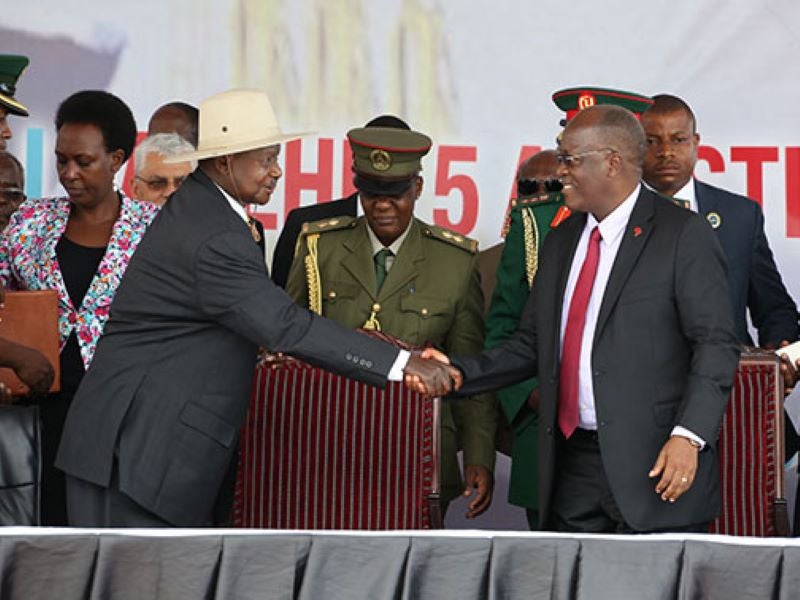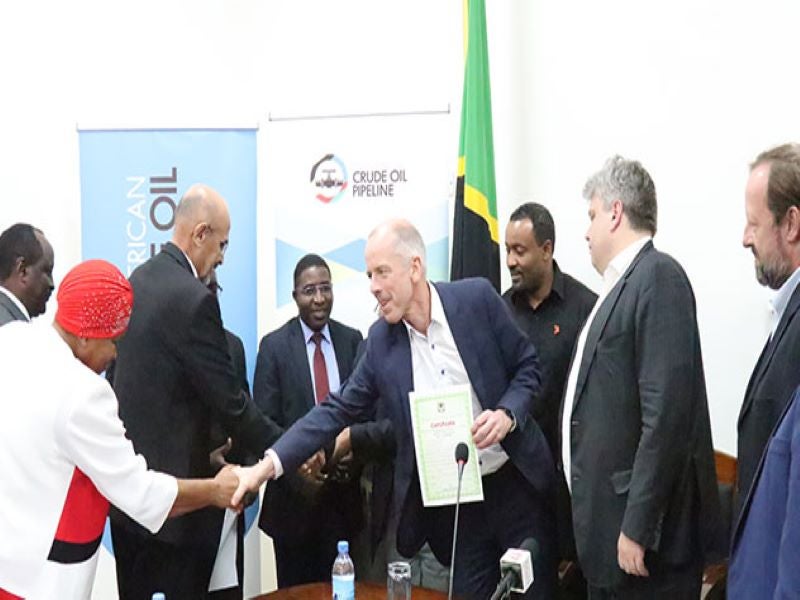The East Africa Crude Oil Pipeline (EACOP) is a 1,443km pipeline to connect the oil fields around Lake Albert in Uganda to Tanzania’s export terminal in Tanga. Planned to supply up to 216 thousand barrels of crude oil a day from Uganda to Tanzania, it will be the first of its kind pipeline in East Africa and the longest electrically heated crude pipeline in the world.
The pipeline is intended to transport the crude output of two oil fields namely, Kingfisher and Tilenga that are being developed on the shores of Lake Albert by French oil company Total and China National Offshore Oil Corporation (CNOOC). These two fields are estimated to contain up to six billion barrels of recoverable oil resources.
The EACOP project is being developed by a joint venture between Total (66.7%) and CNOOC (33.3%). Total agreed to acquire Tullow’s 33.33% interest in the Ugandan oil assets as well as the oil export pipeline for a cash consideration of approximately £444m ($575m) in April 2020.
The Governments of Uganda and of Tanzania signed an agreement for the development of the East Africa Crude Oil Pipeline (EACOP) in May 2017 and the foundation stone for the pipeline was laid in August the same year.
The project, however, couldn’t proceed due to legal and environmental issues. Uganda and Tanzania signed a Host Government Agreement (HGA) to fast-track the pipeline development in September 2020. A final investment decision on the £2.7bn ($3.5bn) East Africa crude pipeline project is expected by the end of 2020.
EACOP route details
The East Africa crude oil pipeline will stretch for approximately 1,443km from the future Kabaale Industrial Park in the Hoima district of Uganda to the Chongoleani peninsula near the Tanga Port in Tanzania.
The Ugandan section of the pipeline will be approximately 296km-long starting near Hoima, close to Lake Albert, and traversing 10 districts and 25 sub-counties to the Tanzanian border between Masaka and Bukoba.
The Tanzanian section will comprise approximately 80% of the pipeline’s total route length. It will run for approximately 1,147km from the Uganda-Tanzania border and traverse eight regions and 25 districts to terminate at a peninsula north of Tanga in Tanzania.
East Africa crude oil pipeline design
The East Africa crude oil pipeline will comprise 24-inch carbon steel pipe joints and it will have a total of six pumping stations, two pressure reduction stations, and a marine export terminal.
The oil from the Lake Albert basin has a very high viscosity. Hence, the entire pipeline will be electrically heated to maintain a minimum temperature of 50° Celsius to maintain the oil flow.
The 296km-long Ugandan section of the pipeline will have a 30m wide right-of-way (ROW) and comprise of two pumping stations, 19 flow control valves, and four substations to be installed at 50km-60km intervals to power the heat tracing cables of the pipeline.
The electrical power required for heating will be provided from the central processing facility of the Tilenga oil field.
The Tanzanian section of the pipeline will feature four pumping stations and two pressure reduction stations on the coastal section of the pipeline before entering the marine storage terminal adjacent to Tanga Bay. The Tanzanian section will also have a total of 60 flow control valves, as well as 21 electrical substations to heat the pipeline.
Marine storage terminal at Tanga Bay
The marine storage terminal at Tanga Bay will include a 1.9km-long trestle and an oil loading platform for oil tankers. The terminal will comprise four 500,000bbl heated storage tanks to maintain oil at temperatures above 63°C. The required heating temperature will be provided using external re-circulation loops and internal heating coils.
Partners involved
The other partners of the project include the government-owned Uganda National Oil Company (UNOC) and Tanzania Petroleum Development Corporation (TPDC).
The front-end engineering and design (FEED) contract for the project was awarded to the US-based Gulf Interstate Engineering (GIE) in December 2016.
The environmental and social impact assessment (ESIA) report for the project was conducted by the environmental, engineering, and technical services group RSK and Eco & Partner Consult, while Uganda’s National Environment Management Authority (NEMA) was responsible for the review and approval of the ESIA.





